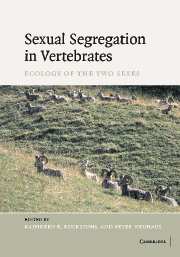Book contents
- Frontmatter
- Contents
- List of contributors
- Preface
- Part I Overview
- Part II Concepts and methodology
- Part III Foraging ecology
- 3 Sex differences in the foraging ecology of large mammalian herbivores
- 4 Sexual segregation in seals
- 5 Sexual differences in foraging behaviour and diets: a case study of wandering albatrosses
- 6 Differences in foraging behaviour and feeding ecology in giant petrels
- Part IV Predator avoidance and reproductive strategies
- Part V Sex-related activities and social factors
- Part VI Sexual differences in ecology: comparisons within different taxa
- Part VII Implications for conservation
- Part VIII Outlook
- References
- Index
5 - Sexual differences in foraging behaviour and diets: a case study of wandering albatrosses
Published online by Cambridge University Press: 04 September 2009
- Frontmatter
- Contents
- List of contributors
- Preface
- Part I Overview
- Part II Concepts and methodology
- Part III Foraging ecology
- 3 Sex differences in the foraging ecology of large mammalian herbivores
- 4 Sexual segregation in seals
- 5 Sexual differences in foraging behaviour and diets: a case study of wandering albatrosses
- 6 Differences in foraging behaviour and feeding ecology in giant petrels
- Part IV Predator avoidance and reproductive strategies
- Part V Sex-related activities and social factors
- Part VI Sexual differences in ecology: comparisons within different taxa
- Part VII Implications for conservation
- Part VIII Outlook
- References
- Index
Summary
OVERVIEW
Albatrosses and petrels (Procellariiformes) are a group of pelagic seabird species that exhibit a wide range in body mass and some degree of sexual dimorphism (Warham 1990; Croxall 1995). Within this order, the K-selected, single-egg clutch, monogamous, biennial breeder, wandering albatross Diomedea exulans (Fig. 5.1), which breeds on various sub-Antarctic islands (Fig. 5.2), is the most sexually dimorphic of any albatross species; although structurally similar to females at all ages, males are approximately 20% heavier and larger than females, and have a whiter plumage (Tickell, 1968; Weimerskirch et al., 1989). Moreover, when comparing the morphometric characteristics of female and male wandering albatrosses, 11 (out of 12) parameters were significantly different (P < 0.001) (Shaffer et al., 2001).
As body size, wingspan and flight performance in wandering albatrosses are known to be positively related (i.e. males have longer wingspan and higher wing loading than females) (Shaffer et al., 2001), sexual size dimorphism may have a functional influence on the capacity to transport food (particularly important whilst breeding) and at-sea distribution of wandering albatrosses. With the recent development of small satellite tracking devices and additional instruments (e.g. activity recorders, stomach probes, GPS devices; Prince & Francis, 1984; Prince & Walton, 1984; Jouventin & Weimerskirch, 1990b; Wilson et al., 1992; Weimerskirch et al., 2002), a detailed characterization of foraging patterns of male and female wandering albatrosses can be obtained.
- Type
- Chapter
- Information
- Sexual Segregation in Vertebrates , pp. 74 - 91Publisher: Cambridge University PressPrint publication year: 2006
- 1
- Cited by

